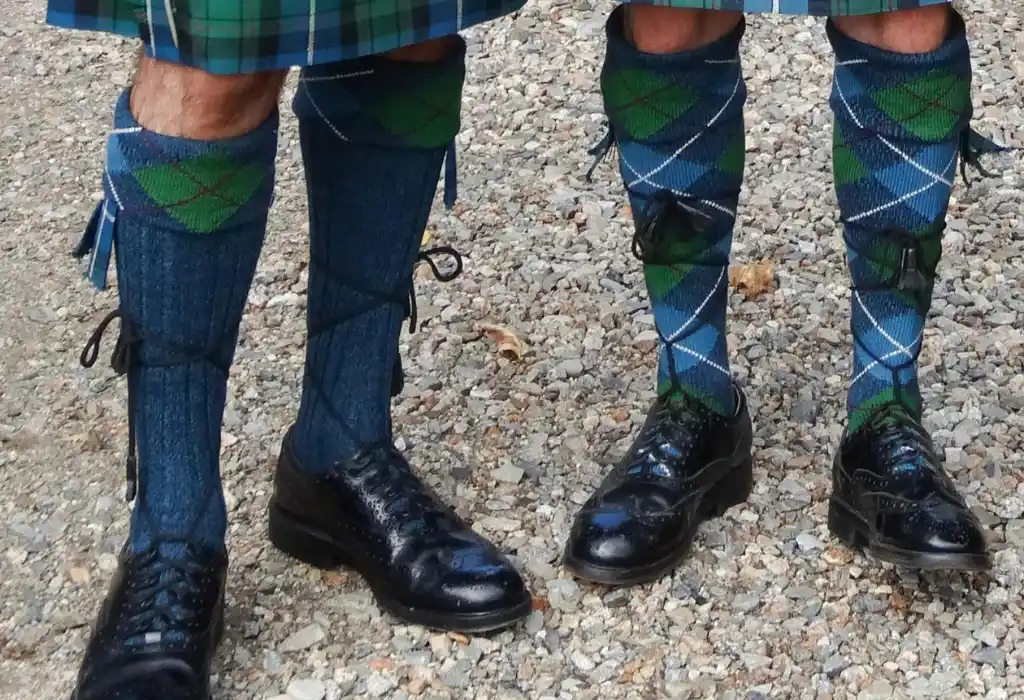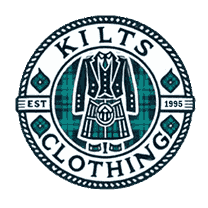The Significance and Style of Classic Colored Kilt Flashes

Kilt flashes are an essential component of traditional Scottish Highland kilt accessories, serving both a functional and decorative purpose. These small strips of fabric or garter flashes are worn around the calf, peeking out from the top of the kilt hose (socks) and often matching or complementing the kilt itself. When it comes to classic colored kilt flashes, they carry significant cultural, historical, and stylistic value. are
Understanding Kilt Flashes: A Brief Overview
Kilt flashes are traditionally worn to secure the kilt hose in place and add a decorative element to the outfit. They consist of two strips of fabric attached to an elastic band that wraps around the leg under the turned-over top of the kilt hose part of kilt accessories.
The ends of these fabric strips hang down and are visible just below the fold of the hose. Kilt flashes are typically made from wool, matching the fabric of the kilt. However, they can also be made from other materials.
Classic Colored Kilt Flashes: Traditional Colors and Their Significance
Classic-coloured kilt flashes typically come in solid colours or tartan patterns that hold traditional and cultural significance. These colours often include:
- Black: A versatile and formal choice, black flashes are suitable for most occasions, particularly formal events like weddings or funerals. They are often paired with more conservative kilt patterns.
- Red: Red kilt flashes are vibrant and bold, symbolizing courage and strength. They are frequently seen at celebratory events and can match a variety of tartan patterns.
- Green: Green flashes are reminiscent of Scotland's lush landscapes and are often associated with nature and heritage. They are popular among those who wish to emphasize their connection to the Scottish Highlands.
- Blue: Blue flashes, often navy, convey a sense of tradition and loyalty. They are a popular choice for those wishing to express their connection to Scottish history and heritage.
- White: White flashes are often used in formal military or ceremonial attire. They represent purity and are typically worn with very formal kilt outfits.
- Yellow: While less common, yellow flashes can add a bright and cheerful element to the kilt outfit. They are often used in less formal or more festive settings.
The Role of Kilt Flashes in Highland Dress
Kilt flashes play a vital role in Highland dress, particularly in maintaining the integrity and presentation of the kilt outfit. They are not merely decorative; they also serve a practical function by holding up the kilt hose.
Without flashes, the hose might slip down, leading to discomfort and a less polished appearance. Moreover, kilt flashes contribute to the overall aesthetic of the outfit. By matching or complementing the kilt, they enhance the visual coherence of the ensemble.
Kilt flashes can also reflect the wearer's clan affiliation, as many are made in tartan patterns specific to different Scottish clans.
The Importance of Matching or Complementing Kilt Flashes
When selecting kilt flashes, it's important to consider how they match or complement the rest of the kilt outfit. The choice of colour or tartan should align with the kilt's pattern and the overall formality of the occasion. For example, for a formal event, black or white flashes may be appropriate, while for a less formal gathering, brighter colours or tartan patterns might be more suitable.
The concept of matching or complementing flashes is not just about aesthetics but also about respect for tradition. In many cases, especially within Scottish culture, wearing mismatched or inappropriate flashes could be seen as a sign of disrespect or lack of knowledge about the traditional dress code.
How to Wear Kilt Flashes Correctly
Wearing kilt flashes correctly is essential for achieving the right look. Here's a step-by-step guide:
- Positioning the Flashes: Start by putting on your kilt hose. Once the hose is in place, position the elastic band of the kilt to flash around the calf, just below the knee. The elastic band should be tight enough to keep the hose up but not so tight that it causes discomfort.
- Securing the Flashes: Fold the top of the kilt hose over the elastic band so that the flashes are securely in place. The fabric strips should hang down from the fold and be visible just below the top of the hose.
- Adjusting for Symmetry: Ensure that the flashes are positioned symmetrically, with the same length of fabric visible on both legs. This symmetry contributes to a polished and professional appearance.
- Final Check: Once the flashes are in place, stand up and check in a mirror to ensure they are even and that the overall look is balanced. Make any necessary adjustments.
The Evolution of Kilt Flashes: From Practicality to Fashion Statement
While kilt flashes originated as a practical item to hold up the kilt hose, they have evolved into a key element of Highland fashion. Over time, flashes have become more decorative, with a wider variety of colours and patterns available to suit different tastes and occasions.
The evolution of kilt flashes also reflects broader changes in fashion. As Highland dress became more formalized in the 19th and 20th centuries, the role of accessories like flashes became more prominent. Today, flashes are often chosen not just for their practicality but also for their ability to enhance the overall look of the outfit.
Modern Trends in Kilt Flashes
In recent years, there has been a resurgence of interest in traditional Scottish dress and, with it, a renewed focus on kilt flashes. While classic colours and patterns remain popular, there is also a growing trend toward personalization and customization.
Many kilt wearers now choose flashes that reflect their style or even their favourite colours rather than strictly adhering to traditional choices.
This trend has led to a broader range of options available, from bright neon colours to custom tartans designed for specific events or occasions.
Another modern trend is the use of high-quality materials. While wool remains the most common material for kilt flashes, some are now made from luxurious fabrics like silk or cashmere, offering a more refined look and feel.
How to Choose the Right Kilt Flashes for Your Outfit
Choosing the right kilt flashes can make a significant difference in the overall appearance of your Highland dress. Here are some tips for selecting the perfect flashes:
- Consider the Occasion: For formal events, stick to classic colours like black or white, or choose tartan flashes that match your kilt. For less formal occasions, you can be more adventurous with colours and patterns.
- Match Your Kilt: If you're wearing a tartan kilt, consider matching your flashes to the dominant colour in the tartan. Alternatively, you can choose a contrasting colour that complements the kilt.
- Think About Comfort: Ensure that the elastic band of the flashes is comfortable and won't dig into your leg. The material should also be soft and not irritate.
- Personal Preference: Ultimately, your choice of kilt flashes should reflect your style. Whether you prefer traditional or modern styles, the most important thing is that you feel comfortable and confident in your outfit.
The Cultural Significance of Kilt Flashes
Kilt flashes are more than just an accessory; they are a symbol of Scottish heritage and pride. Wearing them correctly and with the appropriate outfit shows respect for tradition and an understanding of the cultural significance of Highland dress.
For many Scots, kilt flashes are also a way to express their clan identity. By wearing flashes in the same tartan as their kilt, individuals can showcase their connection to a particular clan or family, adding a layer of personal meaning to their outfit.
Caring for Your Kilt Flashes
Proper care and maintenance of your kilt flashes are essential to ensure they last and continue to look their best. Here are some tips for caring for your kilt flashes:
- Cleaning: Wool kilt flashes should be cleaned according to the care instructions, typically by hand washing in cold water or dry cleaning. Avoid using harsh detergents or bleach, as these can damage the fabric.
- Storage: Store your kilt flashes in a cool, dry place away from direct sunlight. Avoid folding them in a way that could cause creases, especially for tartan patterns.
- Maintenance: Regularly check the elastic band to ensure it hasn't stretched out or become loose. If necessary, replace the elastic to maintain a secure fit.
- Repair: If your flashes become damaged, such as the fabric fraying or the elastic breaking, consider having them repaired by a professional. This can extend their lifespan and keep them looking sharp.
Conclusion
Classic-coloured kilt flashes are a small but significant part of traditional Scottish dress. They serve both a practical and decorative purpose, adding a touch of colour and personality to the kilt accessories. Whether you choose a traditional tartan pattern or a solid colour, wearing kilt flashes is a way to honour Scottish heritage and contribute to the timeless appeal of Highland dress.
By understanding the history, significance, and proper way to wear kilt flashes, you can ensure that your outfit is both stylish and respectful of tradition. Whether you're attending a formal event or simply celebrating your Scottish roots, kilt flashes are an essential accessory that brings the entire ensemble together.
FAQs
Kilt flashes should be long enough to hang about 2 to 3 inches below the folded top of the kilt hose, ensuring they are visible without overwhelming the look.
Kilt flashes are worn around the calf, under the turned-over top of the kilt hose, with the fabric strips hanging just below the fold.
While kilt flashes do not strictly have to match the kilt, it is traditional and visually appealing for them to either match the tartan of the kilt or complement its colors. This creates a cohesive and harmonious look in the overall outfit.



